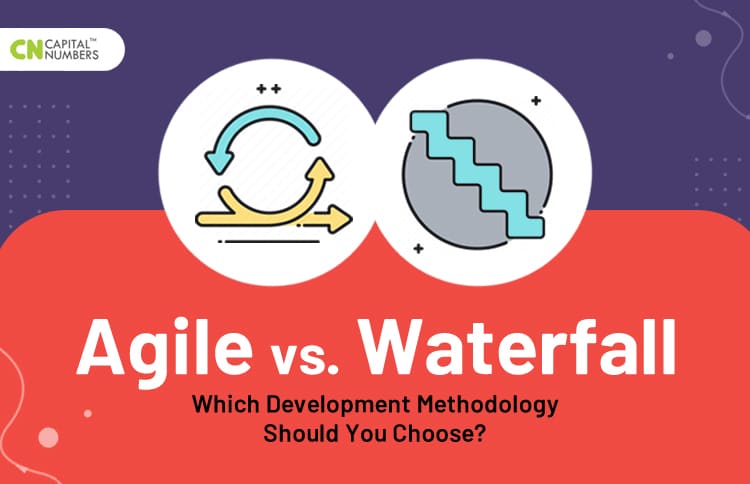Agile vs. Waterfall: Which Development Methodology Should You Choose?
Table of Contents
Whether you’re manufacturing a car or building a house, choosing the right project management methodology is the first step to success. Similarly, it’s essential to pick the right development methodology for software projects to achieve the desired results within the shortest time.
Although there are several methods to develop software, two of the most notable methodologies are Agile and Waterfall. While Agile is best known for its flexibility, Waterfall is a lot more rigid in structure.
Each of these methods has its uniqueness. So, it’s not really about deciding which is the ‘best’ in general. Instead, it’s about deciding which one is the most suitable for your project scope so that your team can adopt the right tools and processes.
In this blog, we’ve outlined the major benefits and drawbacks of both Agile and Waterfall to help you get clarity.
First, let’s take a look at the traditional Waterfall model that was introduced as a software development life cycle (SDLC) before Agile.
The Waterfall Methodology
The waterfall is a linear and sequential software development methodology where each development phase needs to be approved by the project stakeholders before the next phase begins. In this methodology, the progress flows downwards in one direction, hence the name – waterfall. Each of these sequences of events must occur in the following order:
- System and software requirements
- Analysis
- Design
- Coding
- Testing
- Operations
There are several reasons why product teams continue to use the Waterfall methodology despite the Agile method’s recent rise. Some of these reasons include:
Pros of the Waterfall Methodology
- Clear Framework – In the Waterfall model, there is a clear understanding of the project goals, timeline, and deliverables. The entire project scope is agreed upon by the dev team and the customers in advance.
- Documentation – Since this methodology involves meticulous planning, record keeping, and robust documentation, there are hardly any chances of misunderstandings or shortcuts.
- Progress Measurement – Each development phase has clearly defined start and endpoints. Therefore, it is easy to track each team member’s activities and progress in each stage, thereby eliminating resource wastage.
- Hands-off Approach – Once the initial design and project plan is in place, there is hardly any need for ongoing customer supervision until the review phase.
Although the Waterfall methodology is highly structured, it has its drawbacks. For example:
Cons of the Waterfall Methodology
- Little Room for Creativity – Waterfall is heavily dependent on initial documentation and stringent processes. It becomes difficult to incorporate new ideas if the team comes to a roadblock, leaving little room for creativity. This often damages the product quality and jeopardizes client satisfaction.
- Last-minute Testing – The final testing of a software product is done only at the end. So, if errors are detected late in the process, it may lead to product risks. In such a case, a complete rework is expensive and often not feasible.
- Less Customer Involvement – The hands-off approach may seem like a benefit for some projects, there are others that require customer involvement, and the lack of it can hamper desired outcomes.
While the Waterfall model values prior planning, the Agile methodology values adaptability. Let’s find out more below.
You May Also Read: Accelerating Software Delivery: DevOps Best Practices for CTOs
The Agile Methodology
Agile was introduced as a response to the shortfalls of the Waterfall model. Developers realized that they needed something different from the sequential approach of Waterfall to keep up with the continually evolving software industry. So, they created the Agile methodology, which is a collaborative and iterative software development approach. This methodology involves different phases time-boxed as ‘sprints.’ If the list of deliverables, planned at the start of each sprint, doesn’t get completed on time, developers can reprioritize tasks for high-quality results.
Agile focuses on incremental development rather than a linear approach. It heavily depends on ongoing customer inputs throughout every development phase, that is, planning, designing, developing, testing, and releasing. This encourages flexibility and improves client satisfaction.
As opposed to the Waterfall methodology, Agile is a speedier approach that comes with the following benefits.
Pros of the Agile Methodology
- Stakeholder Involvement – Taking the Agile approach allows and encourages continuous collaboration between business stakeholders and development teams throughout the project, thereby evoking trust among everyone involved.
- Adaptability – Since customers get to share feedback during each iteration, it becomes easier to fix issues, rearrange product backlog, and alter development for each sprint.
- Flexible Deliverables – The incremental and iterative Agile structure helps make changes, incorporate new ideas, and reprioritize deliverables. If the customer wants to release the basic software initially instead of the full suite, the Agile model allows that.
- Faster Time-to-market – Agile projects focus less on planning and documentation and more on delivering the working software with each sprint. This accelerates time-to-market and brings success to businesses.
- Teamwork – The Agile model allows cross-functional teams to work as a unit while delivering a software product. Teams extensively coordinate, assess their progress, remain self-organized, and undertake full responsibility for their tasks. This empowers the team members, motivates them, and helps them create high-quality software.
Despite its benefits, the Agile model may pose specific challenges for teams during software development. Some of these include the following:
Cons of the Agile Methodology
- Less Predictable Costs and Timelines – While time-boxed sprints help streamline processes, deliverables can get delayed due to ongoing customer inputs. Creating added sprints in such cases may lead to longer timelines and higher costs.
- Full Commitment – The Agile model requires total commitment from the team members who need to come together and coordinate to deliver a project successfully. This can be a costly and time-taking venture for companies looking to adopt Agile practices for the first time.
- Rework is Inevitable – The iterative nature of the Agile model may lead to frequent rework. This can become cumbersome, especially if it’s a large-scale software project with high-level integrations.
In a nutshell, both Agile and Waterfall are mature software development methods with distinct benefits and drawbacks.
While Waterfall is suitable for projects with fixed scope and budget, Agile is great for projects that demand frequent reviews and adaptation of plans.
Here’s a comparison table to help you delve deeper:
Deciding Between Agile and Waterfall
| Project Trait/Factor | Agile | Waterfall | Comments |
| Customers | Prefers customer availability throughout the project. | Requires customer involvement only at milestones. | Customer involvement minimizes risks in both the models. |
| Scope | Works well even if the project scope is not defined. | Works strictly within the project scope and contract terms. | Change is inevitable, so it’s better to choose adaptability whenever possible. |
| Feature Prioritization | Prioritizes essential features, improves funding efficiency and reduces failures. | Follows stringent processes with limited scope for feature prioritization, often risking failures. | The inability to prioritize features may hamper product quality at times. |
| Team | Prefers dedicated and small teams with high degrees of synchronization and collaboration. | Teams may be large with limited scopes for coordination. | If there’s systematic coordination between customers and team members, the chances of delivering a good quality product are high. |
| Funding | Works well with non-fixed funding but becomes challenging during fixed-price scenarios. | Reduces risks for fixed-price projects by getting agreement upfront. | Fixed-price contracts can be difficult when the project scope is not defined in advance. |
| Summary | It is better to implement Agile practices wherever feasible. | The waterfall can be great for government projects that involve fixed-price quotes. | While Agile ‘makes sense’ for most modern software projects, traditional organization environments still use Waterfall extensively. |
Standish Group Chaos Study shows that Agile projects have higher success rates than projects based on the Waterfall model. The table below further shows the findings in detail:
Project Success Rates: Agile vs. Waterfall
| Methodology | Success Rate | Challenged | Failed |
| Agile | 42% | 50% | 8% |
| Waterfall | 26% | 53% | 21% |
You May Also Read: Agile Strategies for Fixed-Cost Web Development Projects
Key Takeaway
Agile may not follow strict documentation throughout; however, its ability to adapt to ongoing changes makes it a highly preferred methodology over the rather traditional Waterfall.
However, this doesn’t end the Agile vs. Waterfall debate and which one takes the cake.
There is no one-size-fits-all approach to this. If your project demands continuous improvement, flexibility, and quick results, go for Agile. However, if your project requires a robust structure with little to no modification, choose Waterfall.
Decide after you’ve done a thorough analysis of your project’s requirements, scope, and nature.
At Capital Numbers, a renowned software solution company, we have expertise in both Agile and Waterfall approaches. Our experienced professionals can provide expert assistance to help you determine which methodology is the best fit for your project. Visit us to explore more valuable resources and gain insights into effective software development practices. We are just a call away to support your project’s success.















